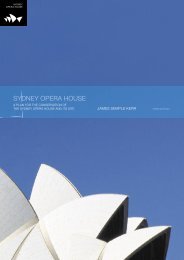nomination by the Government of Australia - Sydney Opera House
nomination by the Government of Australia - Sydney Opera House
nomination by the Government of Australia - Sydney Opera House
You also want an ePaper? Increase the reach of your titles
YUMPU automatically turns print PDFs into web optimized ePapers that Google loves.
22<br />
Part 2. Description<br />
2.23<br />
International design competition 1956<br />
A major cultural centre for <strong>Sydney</strong> and its siting at<br />
Bennelong Point had been discussed since <strong>the</strong> 1940s.<br />
Eugene Goossens, <strong>the</strong> British-born conductor <strong>of</strong> <strong>the</strong><br />
<strong>Sydney</strong> Symphony Orchestra, fi rst proposed this site<br />
in 1948, a recommendation that was later accepted <strong>by</strong><br />
<strong>the</strong> New South Wales Premier, John Joseph Cahill. In<br />
1956 <strong>the</strong> New South Wales <strong>Government</strong> called an openended<br />
international design competition and appointed<br />
an independent jury, ra<strong>the</strong>r than commissioning a<br />
local fi rm. The competition brief provided broad<br />
specifi cations to attract <strong>the</strong> best design talent in <strong>the</strong><br />
world. Open to all architects from around <strong>the</strong> globe, it<br />
did not specify design parameters or set a cost limit.<br />
The main requirement <strong>of</strong> <strong>the</strong> competition brief was a<br />
design for a dual function building with two performance<br />
halls. The competition generated enormous interest<br />
in <strong>Australia</strong> and overseas: 933 architects registered <strong>of</strong><br />
whom 233 (mostly from overseas) submitted a design<br />
on a strictly anonymous basis (Messent 1997: 60–99).<br />
2.24<br />
The New South Wales <strong>Government</strong>’s decision<br />
to commission Utzon as <strong>the</strong> sole architect was<br />
unexpected, bold and visionary. There was scepticism<br />
as to whe<strong>the</strong>r <strong>the</strong> structure could be built given Utzon’s<br />
limited experience, <strong>the</strong> rudimentary and unique design<br />
concept and <strong>the</strong> absence <strong>of</strong> any engineering advice.<br />
The competition drawings were largely diagrammatic,<br />
<strong>the</strong> design had not been fully costed and nei<strong>the</strong>r Utzon<br />
nor <strong>the</strong> jury had consulted a structural engineer (Murray<br />
2004: 13).<br />
Utzon’s design concept included unprecedented<br />
architectural forms and demanded solutions that<br />
required new technologies and materials. Utzon was<br />
only 38 years old and while he was starting to gain<br />
a reputation as an innovative designer he had just a<br />
handful <strong>of</strong> small-scale works to his credit. This was<br />
quite young for an architect to tackle such a large and<br />
complex building, particularly given <strong>the</strong> failure <strong>of</strong> several<br />
talented but inexperienced winners <strong>of</strong> o<strong>the</strong>r international<br />
competitions (Weston 2002: 119). The New South<br />
Wales <strong>Government</strong> also faced public pressure to select<br />
an <strong>Australia</strong>n architect.<br />
Figure 2.23 One <strong>of</strong> Utzon’s original competition drawings, 1956<br />
Figure 2.24 The competition judges with <strong>the</strong> design, from left to<br />
right: renowned English architect Leslie Martin; Cobden Parkes (NSW<br />
<strong>Government</strong> Architect); eminent American-based Finnish architect<br />
Eero Saarinen, and H Ingham Ashworth, Pr<strong>of</strong>essor <strong>of</strong> Architecture,<br />
University <strong>of</strong> <strong>Sydney</strong>.

















